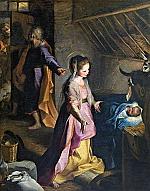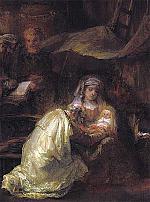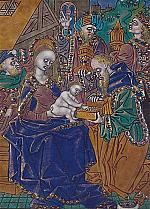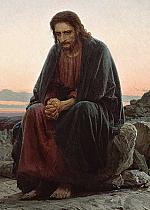Awaiting his coming
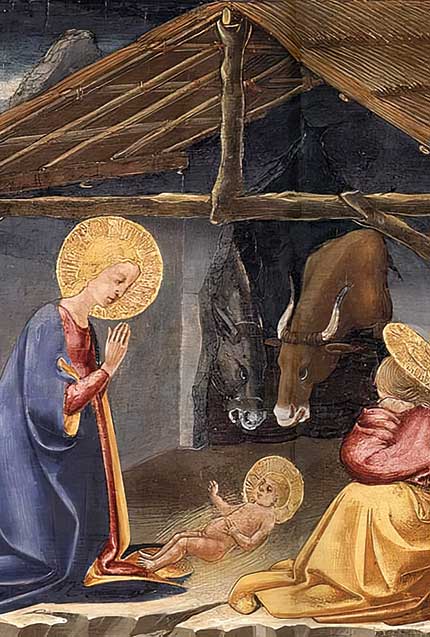
[ABOVE: detail from Neri di Bicci, The Adoration of Christ, 1470s. Tempera on wood—Lindenau Museum / Public domain, Wikimedia]
Today, Christians who observe the church year begin with the season of Advent, a time of preparation that spans the four Sundays before Christmas. However, it was not the first Christian season to develop—its story is deeply rooted in the experience of other fasts and feasts.
Where did it come from?
Christians very early on marked the birth of the Lord on Epiphany, January 6, and in the fourth century some began to also celebrate Christmas on December 25. The first reference to a preparatory season before celebrating Christ’s birth is in 380, when a council at Saragossa declared, “from December 17 until the day of Epiphany which is January 6 no one is permitted to be absent from church.”
In 490 Bishop Perpetuus of Tours said that a period of fasting was to be observed during “St. Martin’s Lent,” already being celebrated between November 11 and January 6. A council held at Tours about 75 years later first mentions the season by name. Just as seekers had prepared during Lent for baptism at Easter since Christianity’s earliest days, so now those who were going to be baptized at Epiphany were also encouraged to prepare during Advent.
Advent began mainly as a time of preparation for celebrating Christ’s first coming in the Incarnation, but today we think of it as encompassing a focus on his Second Coming as well. We owe this emphasis to medieval Celtic Christians.
It took a while for the number of Advent weeks before December 25 to be firmly established. For a long time, Western and Eastern Christians both celebrated six. The East preserves a six-week Nativity Fast that begins in mid-November; Advent was shortened to four weeks in the West in most places in the twelfth century, beginning on or near the feast day of the better-known St. Andrew on November 30 (rather than on St. Martin’s Day). Over time the emphasis on fasting in the West also decreased.
How is the date determined?
In the West, Advent begins on whichever Sunday closest to November 30 allows for four Sundays before Christmas Day. The First Sunday of Advent can be as early as November 27 and as late as December 3; the longest possible Advent is 28 days and the shortest, 22 days, when the Fourth Sunday of Advent falls on Christmas Eve. Most Eastern Christians celebrate a fixed period of 40 days before Christmas (or in the case of Ethiopian and Eritrean Christians, Epiphany) to correspond with Lent and refer to it as the Nativity Fast. (A variety of calendars are used in the Eastern Orthodox Church; for more on this, see p. 45).
Theological themes
Common themes emphasized in Advent include Christ’s birth, his Second Coming, preparation, and repentance. Modern Western celebrations of Advent, as with many of the feasts considered in this issue, are heavily indebted to the ideas of the twentieth-century liturgical movement (which originated in the 1960s among post–Vatican II Roman Catholics and quickly spread to mainline Protestants; see CH #138) and to the Revised Common Lectionary (see p. 1).
The RCL prescribes specific emphases for each Sunday; the first Sunday focuses on Christ’s Second Coming, the second and third tell the story of John the Baptist calling for repentance, and the final Sunday narrates the events right before the birth of Jesus. (For some the third Sunday is called Gaudete Sunday, and it emphasizes the joy of Christ’s coming birth.) In Eastern Christianity the thematic focus during the Nativity Fast is on the saints’ days that happen at that time: Matthew, presentation of the Theotokos in the Temple (see below), Andrew, Barbara, Sabbas, Nicholas, the conception of the Theotokos, Spyridon, and Ignatius of Antioch.
Colors
In the West purple or blue are used. Purple is the more traditional color, but blue gained steam in the twentieth-century liturgical movement and also has historical precedent, especially among Anglicans. In the East red is used.
Customs
In Western liturgical churches, no Christmas carols are sung during Advent (although sometimes one will sneak in on the Fourth Sunday), and the decoration of the sanctuary is often sparse. The Gloria, an ancient song of praise that forms a regular part of worship, is eliminated, and a more penitential song is substituted. Sometimes a nativity scene is placed in the worship space minus the baby Jesus (who will arrive on the evening of December 24) and the Magi (who will arrive on January 6).
An Advent wreath is usually lit near the beginning of the service. Sometimes extra readings are associated with each candle and specific names given to them—usually Hope, Peace, Joy, and Love—and families in the church are invited to begin the service by lighting the wreath. Advent wreaths began among German Lutherans in the nineteenth century and originally had 24 candles—20 red candles for the weekdays from December 1 to 24, and four white candles for the Sundays. The difficulty (and fire hazard) of dealing with so many candles led to the current practice of using four candles—usually three purple and one pink, for the third Sunday of Advent. Often a large white “Christ candle” in the center is lit on Christmas Eve and Day. Advent wreaths are also used for home worship.
From December 17 through December 24, the “O Antiphons” are sung, traditionally at Evening Prayer before and after the Magnificat/Song of Mary (Luke 1:46–55). (The Magnificat is recited at Evening Prayer year-round.) These famous antiphons—which you may know today as the lyrics to “O Come, O Come, Emmanuel”—date back to the eighth century, and each antiphon explores different Old Testament messianic imagery for Christ: Wisdom, Lord (and Lawgiver), Root of Jesse, Key of David, Dayspring, King of the Nations, and Emmanuel.
Advent calendars with a door or window to open for each day also originated among German Christians. The first commercial Advent calendars were printed in the 1920s by Gerhard Lang. In the 1950s Cadbury Chocolates made the first Advent calendar with product samples behind the doors, and by the twenty-first century, hundreds of companies with no discernible Christian influence were advertising with Advent calendars. Many Advent Calendars begin on December 1st even when it is not the first Sunday of Advent.
In Eastern churches the chief custom during this time is the Nativity Fast; except for certain feast days during the 40-day period, the Orthodox abstain from red meat, poultry, meat products, eggs, dairy products, fish, oil, and wine. The Orthodox calendar has 12 Great Feasts, some of which have Western equivalents (see p. 45), and one of them, the Presentation of the Theotokos, falls during these 40 days, on November 21. (Theotokos, Mother of God, is Mary’s most common title in Orthodoxy.)
From December 20 to 24, called the Forefeast of the Nativity, Orthodox worshipers begin to chant Christmas hymns and some churches change their liturgical color to white. On December 24, called Paramony, or preparation, no solid food is eaten until evening, and an all-night vigil is held beginning sometime after sundown. CH
Some things you can do at home
• Use an Advent calendar and/or an Advent wreath. While you don’t have to do readings with either of these, many online resources exist that provide readings for each day.
• Celebrate St. Nicholas’s Day (December 6); give small gifts to your family, eat pastries, and learn about the real Nicholas of Myra (find out how he turned into Santa Claus on pp. 10–13).
• Make stollen, a traditional European Advent dish (originally made without butter because of fasting rules). Find recipes online.
By Jennifer Woodruff Tait
[Christian History originally published this article in Christian History Issue #156+ in 2025]
Jennifer Woodruff Tait is Senior Editor of CH magazineNext articles
Celebrating Christ’s birth
The name “Christmas” is a shortening of “Christ’s Mass” in Middle English
Jennifer Woodruff TaitTwelve days of Christmas
Prolonged celebrations are supposed to start on Christmas day.
Jennifer Woodruff TaitAsh Wednesday
Believers are commanded to observe the beginning of Lent with repentance and prayer.
Jennifer Woodruff TaitSupport us
Christian History Institute (CHI) is a non-profit Pennsylvania corporation founded in 1982. Your donations support the continuation of this ministry
Donate



